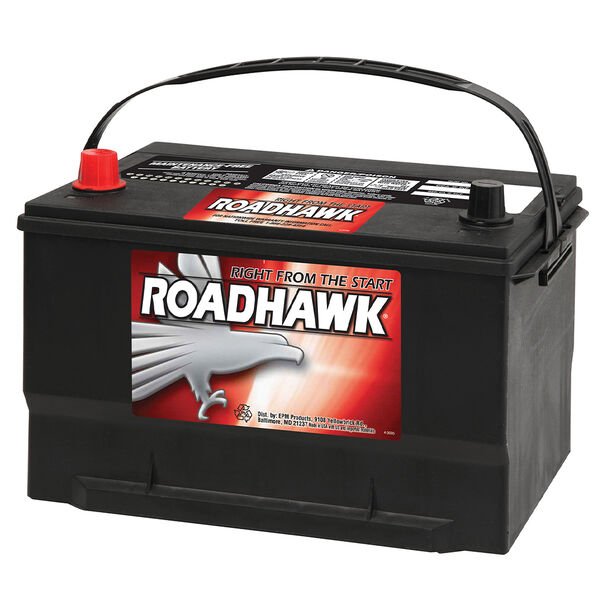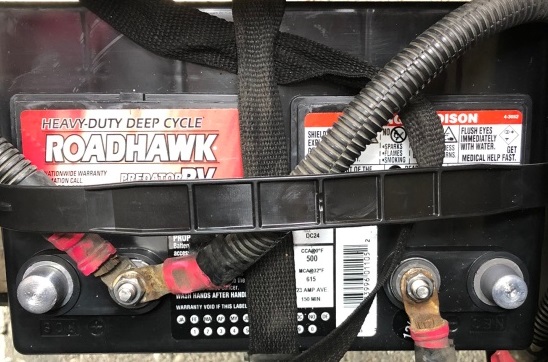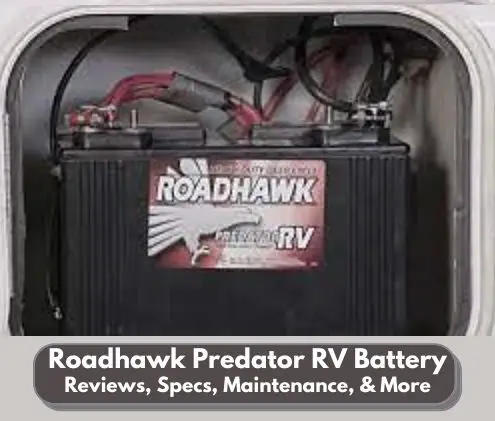If you’ve been in the RV world for any amount of time, you know that having the right battery and maintaining it properly are keys to enjoying your time in your recreational vehicle while you’re away from home. Most RVs have roadhawk predator RV batteries in them, but there is some confusion as to how good these batteries are, who makes them, and how to properly maintain them.
That’s exactly why we put together this in-depth guide to the roadhawk battery to better help you.

Roadhawk Predator RV Battery Review
The Roadhawk RV battery is highly regarded as a long-lasting workhorse that comes installed in some campers.
These batteries are manufactured by Deka, which is a well-known US battery brand.
Many RVers report that these batteries last an extremely long time and can draw down twice as far as other RV batteries on the market.
They’ve got a built-in heater for cold weather along with high-freeze resistance to provide better all weather performance, and the internal cells can easily be changed out in 10 minutes or less if one fails.
Predator RV batteries are designed to protect against ultra-deep discharging which can shorten the life of your batteries.
They use the optimal amount of acid which makes sure the power in the acid is used before the power in the plates.
This design along with the enhanced durability of the plate construction and glass mat protects the battery’s internal components from ultra-deep discharges, giving these batteries extra long life.
They’re also backed by a 10-year warranty which is fantastic for your protection.
What Type Of Battery Is A Roadhawk Predator RV Battery?
The Roadhawk battery is a 12V deep cycle AGM battery.
What do these terms mean, and why do they matter? Let’s do a deeper dive:
Roadhawk Predator AGM Battery
The “AGM” stands for absorbent glass mat, which simply means that the electrolytes are absorbed into a fiberglass mat within the RV battery. This allows them to deliver powerful bursts of starting amps and running your electronics for a long time.
The AGM is a big deal, as it allows more starts per battery, more durable construction, faster recharging, safer handling, easier maintenance, and has special valves protecting the battery’s lifespan.
AGM batteries also withstand vibration and shaking better than typical batteries and are spill-proof.
Roadhawk Deep Cycle Battery
Deep cycle batteries are designed to produce steady power output over extended periods of time, discharging the battery quite a bit, which then must be recharged to complete the cycle.
Deep cycle batteries like the Roadhawk Predator battery are rated by the number of complete cycles they’ll provide, as well as the allowable depth of discharge and the amount of amps it will steadily produce.
Specs like the Cold Cranking Amps and 20 Hour Cap are important when evaluating deep cycle batteries for use in RVs and campers.

Heavy Duty Deep Cycle Roadhawk Predator RV Battery Specs
As we covered earlier, the Roadhawk Predator RV battery is produced by Deka through East Penn in the United States, and is the same as the Deka Intimidator 8A24M model AGM deep cycle battery.
Here are the Roadhawk RV battery specs:
- Voltage: 12V
- CCA (Cold Cranking Amps): 525
- Ref. MCA (Marine Cranking Amps): 800
- R.C. (Reserve Capacity): 135
- Minutes at 25 Amps: 145
- 20 Hour Cap: 79
- Weight: 52lbs
- BCI (Size Rating): 24
- Length: 10 ⅞” / 276mm
- Width: 6 ¾” / 171mm
- Height: 9 ⅜” / 238mm
You can view the Roadhawk Predator RV Battery spec sheet and Deka Intimidator 8A24M product sheet for more info or to compare to other battery models.
Roadhawk RV Battery Amp Hours
The Roadhawk RV Battery’s 20 hour cap is rated at 79, meaning that it can produce 79 Amp Hours for a period of 20 hours.
It’s also rated at 145 minutes of reserve capacity at 25 Amps, so for example if you draw the current on your Predator RV battery at 50 Amps, the battery will last for half that time.

Roadhawk Battery Maintenance
Making sure you maintain your Roadhawk Predator RV battery will ensure the longest life possible, so take the following steps to get the best return from your battery:
Prevent RV Battery Sulfation
Lead sulfate affects how well the battery holds a charge and can build up when the sulfuric acid reacts inside the cells. Make sure it’s fully charged before putting your battery in storage to avoid sulfation.
Store Your RV Battery Properly
Make sure you don’t let your battery drain fully while in storage, and be sure to store it in a temperate, dry area.
Moisture, high heat, and very low temps are all bad for your battery.
Don’t Overcharge Your Battery
Overcharging your battery can reduce the lifespan as well, so pay attention to the instructions and manufacturer’s guidelines on how long to recharge your battery.
Use The Proper RV Battery Charger
Always use the right kind of charger to charge your Predator battery to ensure the correct amount of voltage is being delivered. This prevents overcharging or undercharging and also makes certain that your battery is not damaged during the actual charging process.
FAQs About The Roadhawk Predator RV Battery
The Roadhawk Predator RV Battery is a 12 Volt battery.
The Predator RV battery can also be used in common deep cycle, deep discharge applications like marine trolling, electronics, sailboats, electric vehicles, wheelchairs, golf carts, portable power, floor scrubbers, personnel carriers, and marine house power.
It can also be used in standby and emergency backup applications like UPS (Uninterrupted Power Systems), cable TV, emergency lighting, computer backup, solar power, telephone switching, and village power.


I bought a 2020 Forest River Vibe 31 ft. in Sept 2021. We used our RV at Fort McCoy KOA Jan 20 to the 27. It has been stored since then. We are planning a month long trip starting June 30 to J ul 25. I checked the Battery and it was dead, I took it out and had it recharged and tested it charged to 99% and tested bad.